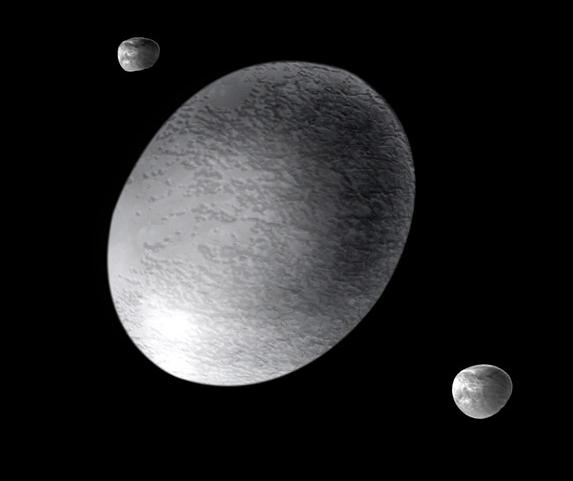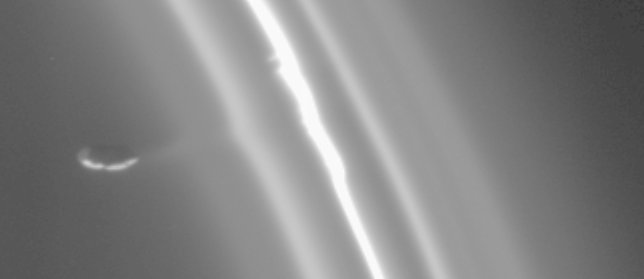a) orbits the Sun
b) has enough mass to be in a hydrostatic equilibrium (is round)
c) has cleared the neighbourhood (in his orbit)
My comment:
a) By this definition extrasolar planets are not planets anymore. The use of this word to classify these extrasolar bodies has been used before (see my last post), so I don't see any need to restrict this definition to the Sun.

b) I agree, but this definition must be more precise. How "round" or how much mass does a body need to have to be a planet? The image in the right is an interpretation of Haumea, a "dwarf planet", that is not very spherical because of its fast rotation.
c) I don't agree. Imagine that in a certain stellar system (even if it is for a small amout of time) we have two giant planets in the same orbit (a circle, and they are in oposite positions in this orbit). Because they did not clear their neighbourhood they can't be planets, even if they are big enough to classify as such? Or imagine double bodies. In our system we have some bodies of big dimensions that did not clear their orbit (Ceres, Pluto, Eris, etc) [this definition of clear orbit is
 not as subjective as it may seem, we can divide the mass of the main body by the mass of the other bodies in the orbit and get a ratio], so it would be enough for them to be in a clear orbit to be planets? I do not see the problem of a belt of bodies that are planets and asteroids, a similar thing happens with Saturn's rings, where we have sheperd moons (here we see Prometheus among some rings) and ring particles in the same orbit.
not as subjective as it may seem, we can divide the mass of the main body by the mass of the other bodies in the orbit and get a ratio], so it would be enough for them to be in a clear orbit to be planets? I do not see the problem of a belt of bodies that are planets and asteroids, a similar thing happens with Saturn's rings, where we have sheperd moons (here we see Prometheus among some rings) and ring particles in the same orbit.But this meeting created two more definitions,
Dwarf planet:
a) orbits the Sun
b) has enough mass to be in a hydrostatic equilibrium (is round)
c) has not cleared the neighbourhood (in his orbit)
d) is not a satellite
I do not agree 100% with this definition. But what I find ridiculous is that dwarf planets are not a subclass of planets, but a different class of bodies. As the name points, they are planets, but dwarf ones! I don't understand this distinction. My deeper comment:
a) idem from the definition of planet
b) I agree, and I think that this is the definition that must distinguish a planet and an asteroid, but as I said before it needs to be more accurate...
c) Why this one to the definition of dwarf planet? Wouldn't "dwarf" has more to due with size? (Of course size has to due with orbital clearing, but...) If we want to keep this definition why not a more related name? Like sheperd planet (just an example, from the moons of Saturn)
d) I agree, but satellite is clearly defined?
And the "wastebasket" of the Solar System:
Small Solar System Bodies (!)
a) What's left, except satellites
Where is the definition of asteroid, of comet, of meteor? We just have "small solar system bodies" (SSSB)? I propose that we use the name asteroid for these bodies, and create asteroid subclasses to comet (asteroid with a certain composition and orbit) and meteor (small sized asteroids) The name SSSB seems to be a clear sign of disinterest with these objects...
This definition fails in some points. I would like to see the definition of double body (double planet or double asteroid) and its relation with satellite. The proposal often used is that a double
 body is a system where the center of mass is located outside both bodies, unlike body + satellite, where the center of mass is inside the bigger body, being the satellite the other. In the Solar System there are bodies like this: Pluto-Charon has a center of mass outside Pluto, so it seems to me that the classification of Charon as a satellite of Pluto is not correct. There are more extreme situations like the asteroids 90 Antiope (image in the right) and 1997 CS29, that are two systems with similar sized bodies, being ridiculous the idea that one dominates the other. In my opinion we lack this definition.
body is a system where the center of mass is located outside both bodies, unlike body + satellite, where the center of mass is inside the bigger body, being the satellite the other. In the Solar System there are bodies like this: Pluto-Charon has a center of mass outside Pluto, so it seems to me that the classification of Charon as a satellite of Pluto is not correct. There are more extreme situations like the asteroids 90 Antiope (image in the right) and 1997 CS29, that are two systems with similar sized bodies, being ridiculous the idea that one dominates the other. In my opinion we lack this definition.
As this definition focus only in the Solar System, the problem of brown dwarfs is not important (as it seems the idea of Sol b is not likely), but if we want to extend one definition beyond our system we must look at this problem. In the right we have the star Gliese 229 A and the brown dwarf Gliese 229 B (smaller body).
My final point is that this definition was voted by a small amout of the astronomical community, even among IAU. Perhaps if the others vote this definition is taken out...
Note: all these images come from wikipedia.


No comments:
Post a Comment